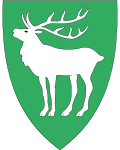Hjartdal Municipality Hjartdal kommune | |
|---|---|
 View of the Hjartdal wilderness | |
 Telemark within Norway | |
 Hjartdal within Telemark | |
| Coordinates: 59°39′54″N8°43′34″E / 59.66500°N 8.72611°E | |
| Country | Norway |
| County | Telemark |
| District | Aust-Telemark |
| Established | 1 Jan 1838 |
| • Created as | Formannskapsdistrikt |
| Administrative centre | Sauland |
| Government | |
| • Mayor (2015) | Bengt Halvard Odden (Ap) |
| Area | |
• Total | 791.60 km2 (305.64 sq mi) |
| • Land | 737.12 km2 (284.60 sq mi) |
| • Water | 54.48 km2 (21.03 sq mi) 6.9% |
| • Rank | #146 in Norway |
| Population (2023) | |
• Total | 1,588 |
| • Rank | #299 in Norway |
| • Density | 2.2/km2 (5.7/sq mi) |
| • Change (10 years) | |
| Demonym | Hjartdøl [1] |
| Official language | |
| • Norwegian form | Nynorsk |
| Time zone | UTC+01:00 (CET) |
| • Summer (DST) | UTC+02:00 (CEST) |
| ISO 3166 code | NO-4024 [3] |
| Website | Official website |
Hjartdal is a municipality in Telemark county, Norway. It is located in the traditional district of Upper Telemark and Aust-Telemark. The administrative centre of the municipality is the village of Sauland. Other villages in the municipality include Tuddal and Hjartdalsbygda.
Contents
- General information
- Name
- Coat of arms
- Churches
- History
- Government
- Mayors
- Municipal council
- Geography
- Transportation
- Notable people
- References
- External links
The 792-square-kilometre (306 sq mi) municipality is the 146th largest by area out of the 356 municipalities in Norway. Hjartdal is the 299th most populous municipality in Norway with a population of 1,588. The municipality's population density is 2.2 inhabitants per square kilometre (5.7/sq mi) and its population has decreased by 1.3% over the previous 10-year period. [4] [5]


